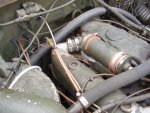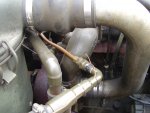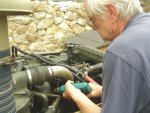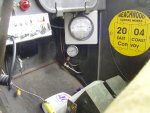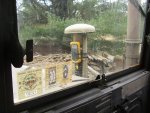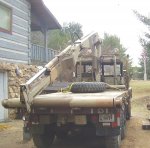- 10,350
- 75
- 48
- Location
- Meadows of Dan, Virginia
Installed two more temperature probes today to measure the effect of the water cooled intake manifold.
Drilled a 1/16 inch dia hole at the cylinder #5 intake (see image) and also a 1/16 inch dia hole in the intake manifold adapter.
Two thermocouple bead type probes were installed.
I also installed a temporary pressure/vacuum gauge to monitor the air filter canister vacuum.
After warming the engine to about 175F and making preliminary measurements, I took the deuce on test drive.
On a long uphill run in 5th gear at 55 mph the engine temp was 185F, the pyro showed 1,100 F, the boost gauge 10-11 psi, the adapter temp 222F and the temp at #5 cylinder 210F. The cooled intake manifold acts as an itercooler here.
Love that friggin multi!
The vacuum was 2 inches of water at 2,000 rpm, it pegged the needle at 2,500 rpm (conditions as above). The gauge only goes to 2 inches.
Drilled a 1/16 inch dia hole at the cylinder #5 intake (see image) and also a 1/16 inch dia hole in the intake manifold adapter.
Two thermocouple bead type probes were installed.
I also installed a temporary pressure/vacuum gauge to monitor the air filter canister vacuum.
After warming the engine to about 175F and making preliminary measurements, I took the deuce on test drive.
On a long uphill run in 5th gear at 55 mph the engine temp was 185F, the pyro showed 1,100 F, the boost gauge 10-11 psi, the adapter temp 222F and the temp at #5 cylinder 210F. The cooled intake manifold acts as an itercooler here.
Love that friggin multi!
The vacuum was 2 inches of water at 2,000 rpm, it pegged the needle at 2,500 rpm (conditions as above). The gauge only goes to 2 inches.
Attachments
-
185.7 KB Views: 661
-
161.4 KB Views: 654
-
201.8 KB Views: 665
-
172.1 KB Views: 664



